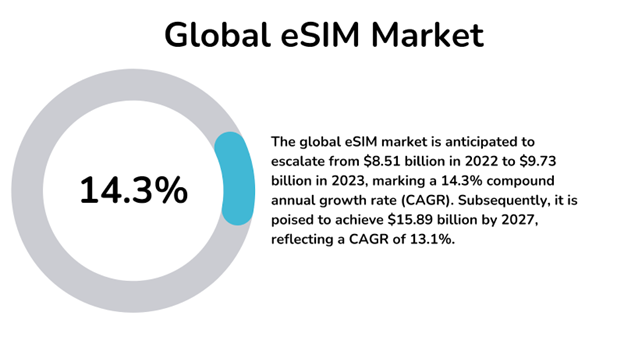Connect with us

Maximizing Efficiency with eSIM: Proven Strategies for Effective Business Management
The advent of eSIM (embedded SIM) technology is transforming connectivity and unlocking major efficiency benefits for businesses across industries. eSIM offers a programmable, remote SIM solution that brings substantial advantages over traditional physical SIM cards in terms of cost savings, scalability, security, and seamless global mobility.
This article outlines proven strategies for eSIM implementation and provides expert insights on how enterprises can leverage eSIM solutions for optimized operations and future-proof growth.
The Strategic Advantages of Adopting eSIM
Integrating eSIM technology for business devices and systems offers tangible improvements by cutting expenses and overhead. Key eSIM benefits include:
- Cost Reduction: eSIM eliminates the logistical/financial burdens of SIM management, providing long-term cost savings.
- Enhanced Security: Advanced encryption with eSIM safeguards company data across locations.
- Simplified Scalability: eSIM enables seamless onboarding of new connected devices through remote provisioning.
- Global Connectivity: eSIM facilitates device connectivity across 190+ countries - crucial for mobile business needs.
Take a look at the below chart that illustrates the global eSIM market growth, with significant expansion expected between 2022 and 2027.

Industry reports show the global eSIM market at USD 253.8 million in 2019 projected to reach USD 978.3 million by 2023, exhibiting a 30.9% CAGR as more enterprises realize the technology's potential.
Furthermore, the adoption of eSIM technology fosters innovation and agility within organizations, empowering them to swiftly adapt to evolving market dynamics and stay ahead of competitors. Find out more about how eSIM integration can revolutionize your business operations and drive sustainable growth in the digital age.
Key Use Cases Driving Efficiency Improvements
Optimized Device Deployments
eSIM mobile connectivity allows enterprises to instantly activate and manage devices across locations through programmable APIs instead of manual SIM insertion. The remote provisioning capacities of eSIM solutions streamline deploying equipment at scale, saving costs and enhancing time-to-market for technology-driven businesses.
This approach also enables automating device onboarding and configuration changes across distributed hardware ecosystems seamlessly. Furthermore, eSIM architecture provides the flexibility to switch connectivity plans or carriers remotely as business needs evolve.
Streamlined BYOD Management
eSIM for business makes implementing “Bring Your Own Device” (BYOD) policies easier without compromising security. Employees can safely access company data and tools on personal devices as IT maintains control over eSIM profiles.
This improves employee satisfaction by providing choice in gear while ensuring corporate data protection needs. Additionally, eSIM-based BYOD results in lower overhead for enterprises by reducing device procurement, maintenance, and upgrade costs significantly.
| Without eSIM | With eSIM BYOD |
| Purchasing/subsidizing staff mobile devices | $0 device subsidies |
| Separate personal and work phones | Single device for work and personal use |
| Security risks of personal gadgets | Secure eSIM profile limits access per policy |
Seamless IoT Fleet Management
The rising Internet of Things (IoT) adoption has businesses managing thousands of connected sensors and gadgets. eSIM solutions tackle this scale through remote, over-the-air connectivity configuration of entire IoT fleets. IT teams can track or modify device parameters across global facilities via unified dashboards.
eSIM technology simplifies device management, offers global connectivity, and eliminates the need for physical SIM cards, enhancing scalability for IoT deployments. Remote SIM provisioning solutions enable seamless OTA management of eSIMs and mobile subscriptions, providing high-performance connectivity for IoT use cases.
By leveraging eSIM solutions, businesses can efficiently manage large-scale IoT deployments, streamline connectivity configurations remotely, and ensure seamless operations across global facilities.
Revolutionizing Logistics with eSIM
eSIM technology is transforming supply chain operations by enabling real-time visibility and management of assets across the globe. With eSIM, supply chain transparency reaches new heights, providing actionable insights into freight movement across complex distribution networks.
This creates opportunities for predictive logistics by unlocking real-time data across the end-to-end shipment lifecycle. From origin to destination, eSIM gives logistics leaders an invaluable competitive edge through enhanced visibility across land, air, and sea cargo transit routes globally.
For instance, eSIM solutions allowed FleetForce to track over vehicles and optimize routing, reducing fuel costs. With eSIM, businesses gain an unprecedented level of control and efficiency in coordinating complex logistical chains spanning various regions.
Harnessing eSIM for Enhanced Digital Transformation in Business
Integrating eSIM technology enables businesses to leverage advanced connectivity solutions that drive innovation and efficiency. eSIM acts as a catalyst for digital transformation with a significant impact on business models, operations, and customer engagement.
Their implementations have led to improved efficiency, agility, and ability to make data-driven decisions across eSIM-adopting enterprises. Furthermore, eSIM technology enhances security measures by enabling remote provisioning and management of credentials, reducing the risk of unauthorized access and data breaches.
This streamlined approach also facilitates seamless integration with IoT devices, empowering businesses to scale their operations and capitalize on emerging opportunities in the connected ecosystem.
Additionally, the flexibility of eSIM solutions fosters dynamic business strategies, allowing enterprises to adapt swiftly to market demands and stay ahead of competitors in today's fast-paced digital landscape.
The Role of eSIM in Consumer Devices
The adoption of eSIM technology in popular smartphones and tablets like iPhones and Android devices has opened new gateways for businesses to engage customers. With eSIM-backed connectivity, rolling out organization-specific plans onto employee devices is seamless.
This allows secure access to business apps and data from personal gadgets. As more smart consumer products integrate eSIM, they offer immersive brand experiences for end-users while unlocking strategic advantages for enterprises.
Moreover, the integration of eSIM technology in consumer devices simplifies the onboarding process for users, reducing the need for physical SIM cards and enabling instant activation of cellular services.
Additionally, the versatility of eSIMs facilitates global connectivity, empowering consumers to seamlessly switch between networks while traveling without the hassle of changing physical SIM cards, thus enhancing user experience and convenience.
Optimizing Business Operations With eSIM-Enabled Global Connectivity
eSIM technology optimizes global business operations by simplifying cross-border connectivity management. Enterprises can easily monitor and manage international assets via unified dashboards.
For example, eSIM enabled IoT solution provider SensorsInc to seamlessly track over 1000 assets across 190 countries with minimal data roaming costs.
By reducing dependency on physical SIM swaps and complex carrier negotiations, eSIM for business ensures uninterrupted worldwide cellular data connectivity. This is instrumental for organizations managing multifaceted supply chains, international logistics, and distributed workforces.
Enhancing Online Business Efficiency
For online businesses, eSIM integration brings the power of on-demand global connectivity. Instead of relying on physical SIM cards, eSIM facilitates flexibility in offering uninterrupted data services to customers worldwide.
Additionally, eSIM-powered IoT integration helps online enterprises efficiently manage inventory, and logistics and deliver exceptional service through real-time coordination across departments. By leveraging eSIM, online businesses can drive higher revenues by providing robust omnichannel experiences.
Moreover, the remote management capabilities of eSIM technology enable online businesses to easily provision, activate, and deactivate cellular connectivity for their devices, enhancing operational efficiency and reducing overhead costs associated with traditional SIM card management.
eSIM's Role in Empowering Remote Workforces and IoT Integration
eSIM solutions support the evolving workplace by keeping remote employees connected through seamless device connectivity. As opposed to traditional SIM management, eSIM allows secure access control policies while providing flexibility to use personal gadgets.
Likewise, integrating eSIM with IoT endpoints ranging from sensors to vehicles enhances real-time data collection, automation, and remote control.
For instance, hospitals deployed an eSIM-IoT infrastructure for continuous patient health monitoring with wearables, storing data in the EMR application securely. IoT-triggered alerts reduced the need for on-site doctor visits thereby optimizing healthcare delivery.
With innovations like IoT and remote work rising steadily, eSIM integration is key to deriving maximum value from such advances through smarter, tightly integrated implementations.
Strategic eSIM Integration Approach
Migrating business systems to eSIM warrants planning and systematic execution for maximum ROI and minimal disruption.
- Assess Connectivity Requirements: Conduct cross-departmental analysis of use cases like company phones, IoT sensors, vehicle trackers, etc. to define specifications.
- Create Implementation Roadmap: Outline phased rollout plan based on priority devices, locations, migration timelines, etc.
- Configure eSIM Policies: Embed policy controls into the eSIM profile as per the departmental use case for optimized management.
- Support Transition: Set up self-help and tech assistance resources to facilitate employee adoption.
The eSIM-Enabled Future of Mobility
While early eSIM applications revolved around connectivity, its capabilities continue evolving alongside 5G, enhanced security protocols, and other innovations to enable sophisticated implementations.
As trends like IoT, private 5G networks and augmented reality go mainstream, eSIM integration will be key to harnessing their full potential while keeping business data secure. eSIM's flexibility also future-proofs enterprises to cost-effectively leverage emerging technologies.
Conclusion
With a strategic approach, integrating eSIM for business optimization unlocks immense potential for enterprises to enhance both efficiency and agility. eSIM is at the core of the next mobile revolution.



.jpg)
.jpg)



